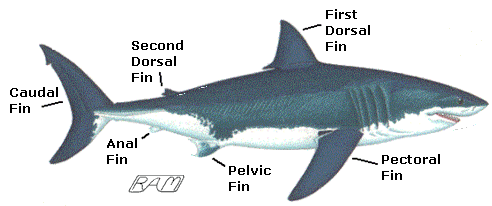Analogous Traits
a) Sharks are
cartilaginous fish and typically live in very deep waters of the ocean. They
have gills and breathe by extracting oxygen from the water. They are
carnivorous hunters and spend most of their time searching for food. Dolphins
are marine mammals and generally live in shallow waters. They have lungs and
nurse their young, and they are also carnivores.
b) Sharks and
dolphins both possess the analogous trait of dorsal fins and pectoral fins.
They need these fins in order to maintain stability while swimming with
agility. Dorsal fins sit on top of both of the animals and help keep them
upright. Pectoral fins are located on the sides and help them turn and stop.
Both the animals had to develop these fins because they needed them in order to
swiftly swim, not because their ancestors shared this common trait.
c) No, the
common ancestor of sharks and dolphins could not have shared this trait. We
know this because sharks are fish, whereas dolphins are descended from mammals.
As a result, their common ancestor could not have had this trait.
Homologous Traits
a) Crocodiles
are aquatic reptiles that are carnivorous and are adept swimmers. They have a
streamlined body and four limbs. Mice are small rodents with tiny ears and long
tails. They have four limbs and an extremely good sense of hearing.
b) The
homologous trait these two share in common is four limbs. The same bones
support both animals, but they are differently shaped. Crocodiles implement a "high
walk" where they lift their entire body trunk and at least the
anterior half of their tail clear of the ground. Crocodiles also use their
limbs to help them swim. Mice use all four limbs to walk and run. They stand on
their hind legs a lot more than crocodiles do, mainly to eat. Ultimately, even
though they share the same limbs, they use them for differently and they are
shaped differently.
c)
The ancestor of crocodile and mice are tetrapods, which are animals that are
vertebrates. We know that tetrapods developed limbs because we can see these in
fossil records.





I really enjoyed your Analogous Trait comparison. With sharks, and dolphins being so simple looking I have found working in child education young children often have a hard time understanding that dolphins are not fish. great post!
ReplyDeleteGreat post here. I also compared the shark and dolphin so I liked the way you had explained the related traits and also how you had broke it down.. It was quite different then how i had did it myself, so it was nice to read someone bring a different perspective to it. Also I had no idea the mice and crocodile had the same ancestor, very cool!
ReplyDeleteAwesome post Halle! I never would've thought that mice and crocodiles would have a common ancestor seeing as how mice don't swim and crocodiles do. So that was a fascinating thing to learn. Your dolphin and shark similarity didn't shock me as much but it was educational reading that section of your post.
ReplyDeleteGood description of your analogous traits. Careful on your ancestry, however. The common ancestor of the shark and the dolphin can be found 100's of millions of years back in the early fishes, so the common ancestor did have these traits and passed them onto the shark. So why aren't these homologs? Because the dolphin acquired these traits independently, deriving them from the limbs of their mammalian land ancestor. That means there is no genetic commonality, making these indeed analogs.
ReplyDeleteClear example of a homologous trait. The four limbed structure is easily traceable through the fossil record and you did a good job of explaining their structural/functional differences.